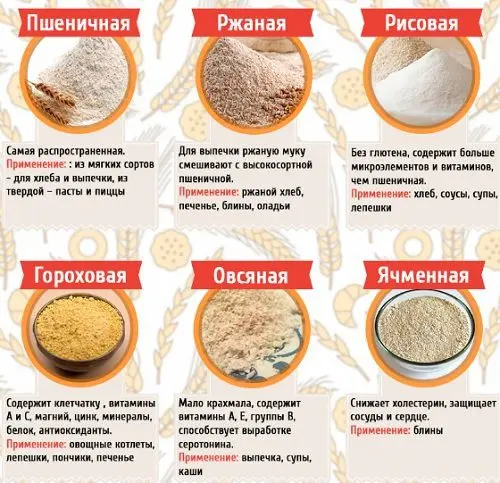😉 Greetings to the venerable audience! In the article “How to choose the right flour: good advice for housewives”, you will learn how to determine the quality of this product by taste, smell, color and shelf life. For you an interesting video on the topic.
It is the only food that people of all races, cultures and religions consume. From time immemorial, each nation has its own traditions in the preparation of bread and flat cakes. No religious movement, no national customs prohibit the consumption of nutritious and healthy grains, flour and bread.
Grain is a living organism that is dormant under normal storage conditions. To maintain his life, a constant metabolism takes place. And all the valuable substances that are useful to the embryo for germination are contained in it in maximum concentrations.
Interestingly, a person gets almost half of all energy consumed from bread. Bread is the oldest food that people learned to cook back in the Neolithic period.
Types of flour
This food product is obtained from wheat, rye, buckwheat, oats, barley, millet, corn, rice. It is subdivided into grades: extra, higher, first, second, wallpaper and krupchatka.
Let’s start with the fact that it is not worth buying it exclusively of the highest grades: after all, during production, the grain is completely cleaned along with all the useful substances that are contained in the shell.

Give preference to coarse flour – there are much more trace elements and vitamins in it than in the highest grade. True, whole grain flour also has one drawback – the smallest amount of baked goods, because it has a very low level of gluten.
How to determine the quality of flour
Taste
Take a small pinch of flour and taste it; if it is fresh, you will experience a slightly sweet taste. If you experience a moldy taste, it means that the product has been stored improperly and it is highly undesirable to use it in food. If you feel bitterness, the product is expired.
Smell
Usually fresh flour is odorless. If you smell damp, musty, then, most often, the reason lies in the “potato disease”. It is absolutely harmless to humans, but it spoils the taste of baked goods and their appearance. As a rule, the “potato disease” is prone to flour of the highest grade, stored in the heat.
Shelf life
Freshly made flour has very weak baking properties. Therefore, it is best to choose this product from the production date which has passed about two weeks. Please note that flour has a short shelf life of 3 to 6 months, so do not buy it for future use.
Color
The color often ranges from white to creamy shades. Therefore, it is rather difficult to determine the freshness of dry flour by color. But there is one simple way: take a handful of flour and mix it with water. Knead a small lump and wait a little (no more than a minute). If it is stale, the dough will take on a dirty gray tint.
Tip: Buy the product only in paper bags. If the package is made of polyethylene, then it cannot “breathe” and acquires a musty smell. Don’t be lazy to read the composition information.
How to choose flour
😉 Gentlemen, if you find the article “How to choose flour” interesting, share it in social media. networks.









